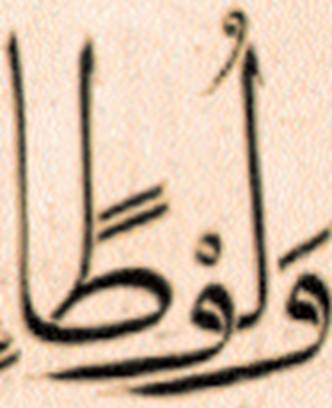[Date Prev][Date Next][Thread Prev][Thread Next][Date Index][Thread Index]
Re: Sequential Fathatan Final Form (Items 9 and 10)
- To: "General Arabization Discussion" <general at arabeyes dot org>
- Subject: Re: Sequential Fathatan Final Form (Items 9 and 10)
- From: "Thomas Milo" <t dot milo at chello dot nl>
- Date: Wed, 16 Jun 2004 18:41:25 +0200
Salaam Mohammed,
Regarding the logical or nominal order of the characters, it would help if
you could explain a bit clearer why you think the Qur'an should be printed in
modern spelling. I was not aware of this requirement.
I have only seen Mushafs in manuscript and the singular typeset edition
from Cairo, that place the fathatan (Arabic for: "two fatha's") on top of the
letter that governs the other two cases of tanween as well. Below is a striking
example from the famous Suhrawardi Mushaf written in Mamluki style that leave no
doubt that Suhrawardi did not even remotely associate the two fatha's with the
trailing alif:
Wa s-salaam,
Thomas
----- Original Message -----
Sent: Wednesday, June 16, 2004 6:07 PM
Subject: Re: Sequential Fathatan Final Form (Items 9 and 10)
> Salaam Mohammed,
>
> > I agree
with you that since sequential fathatan
> > are only used
>
> in the Qur'an, the font can assume that the needed
> >
character
> > is the one in the image.
>
> But my point is that they have to consistent with
> >
the regular
> > fathatan.
> > If I
typed regular fathatan and then Alef, How can
> > the font
>
> decide if I want the form like in the image (where
> >
the fathatan
> > is as high as the end of the Alef), or
the
> > expected form for
> > regular text (where
the fathatan is *just* above
> > the previous
> >
character not as high as the end of the Alef).
>
> The phenomenon
you are referring to - the variance in
> the absolute positioning of
superscript alef - is not
> a graphemic matter, it is a calligraphic
matter. The
> typeface used in the King Fuad codex prefers to
>
position the superscript alef there whereas in other
> codices the
position the superscript alef may be
> slightly different, and in regular
everyday Arabic
> text it can be just above the previous
character.
> These are calligraphic style issues. Unicode does not
>
encode calligraphic data, it encodes character data
> (or graphemic
data).
>
> Font designers design different fonts for
different
> calligraphic styles. There are fonts for Naskh - and
>
there are many variances of Naskh - Nastaliq, Riqaa,
> Kufic, and other
calligraphic styles. The difference
> between these calligraphic styles is
not recorded at
> the encoding level (i.e. Unicode level). These
>
differences are recorded at the font level (i.e. the
> rendering domain).
Unicode is not meant for encoding
> calligraphic data.
>
> In
order to render Unicode Quran text 'exactly' like
> the popular Quran
mushaf that you find in your home
> (King Fuad or the handwritten clone
printed by
> QuranComplex) you have to design a font typeface that
>
is exactly like it. And this typeface will have
> differences from the
typefaces found in the Ottoman,
> Maghribi, or Rushdi Quran
mushafs.
>
> Personally for me, it is not crucial to design
a
> typeface that is exactly like the King Fuad mushaf.
> The Quran
is not dependent on the calligraphic style
> used to write it, it is the
content that matters most
> to me. But I also see value in designing a
typeface
> that is like the King Fuad Quran since that is what
>
people are familiar with.
>
> > But in anyway, I didn't
mean to offend you, we are
> > all busy but
> > this
issue is extremely important to me and I want
> > my reply to
>
> be reasonable that's why they are long, if I write
> > short
replies,
> > you will find them incomplete.
>
> I
understand. Yes the need to encode the Quran in
> Unicode is also an
extremely important issue for me
> too. Insha'Allah we can propose a
proper solution to
> this problem together.
>
> Kind
regards,
> Mete
>
>
_______________________________________________
> General mailing
list
> General at arabeyes dot org
> http://lists.arabeyes.org/mailman/listinfo/general
